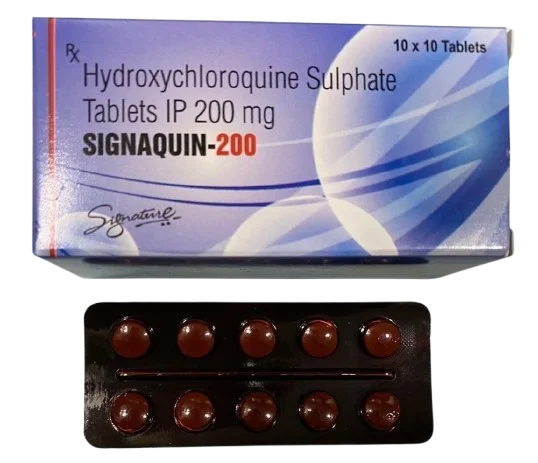What is Signaquin 200mg?
Signaquin 200 mg contains Hydroxychloroquine Sulfate, which has immunomodulatory, anti-inflammatory, and antimalarial properties. Its mechanism of action varies depending on the condition treated, but it primarily influences the immune system and disrupts the parasite's growth.
Mechanism of Action
- Immune Modulation (Autoimmune Diseases)
Suppresses Overactive Immune Response
In conditions like rheumatoid arthritis and lupus, Hydroxychloroquine helps to regulate the immune system by decreasing the activity of specific immune cells (e.g., T-cells and dendritic cells).
Inhibits Inflammatory Pathways
It blocks the release of pro-inflammatory chemicals, such as cytokines (e.g., TNF-alpha, IL-1), and reduces inflammation in joints, skin, and other tissues.
Affects Toll-Like Receptors (TLRs)
Hydroxychloroquine blocks TLR signaling, reducing immune system overactivity and lowering the production of inflammatory molecules.
- Antimalarial Action
Increases parasite's Intracellular pH
Hydroxychloroquine interferes with the ability of malaria parasites to digest hemoglobin by raising the pH inside the parasite's food vacuoles (acidic compartments in its cells). It disrupts the parasite's metabolism and kills it.
Inhibits Replication
It prevents the malaria parasite from replicating and spreading within the body.
- Anti-Inflammatory Action (General)
Prevents Oxidative Damage
Hydroxychloroquine reduces the production of free radicals and reactive oxygen species (ROS), which can damage cells and tissues during inflammation.
Stabilizes Cell Membranes
It helps stabilize lysosomal membranes (organelles involved in breaking down substances within cells), reducing tissue damage caused by inflammation.
- Antithrombotic Effects (Secondary Benefits)
In some autoimmune conditions (e.g., lupus), Hydroxychloroquine reduces the risk of blood clot formation by altering the platelet function.
Where It Works
For Autoimmune Diseases
It reduces inflammation and prevents tissue damage in joints (e.g., rheumatoid arthritis) and organs (e.g., lupus). It Calms overactive immune responses to reduce disease flares.
For Malaria
It kills malaria parasites during their blood stage, stopping their replication and preventing the spread of infection.
Timeline of Effects
Autoimmune Diseases
Improvement in symptoms may take 4–12 weeks, as Hydroxychloroquine works gradually to regulate the immune system.
Malaria
The medication shows its effects within hours to days when used for malaria treatment, depending on the stage of the infection.
What are the Uses and Benefits of Signaquin 200mg?
Uses of Signaquin 200 mg
- Autoimmune Diseases
Rheumatoid Arthritis (RA)
It reduces joint inflammation, pain, and stiffness. It slows disease progression. It prevents long-term damage to joints.
Systemic Lupus Erythematosus (SLE)
It manages symptoms such as skin rashes, fatigue, joint pain, and organ involvement and helps reduce lupus flares.
Discoid Lupus Erythematosus (DLE)
It treats skin-related lupus symptoms, including lesions and sensitivity to sunlight, Sjogren's Syndrome. It relieves symptoms like dry eyes, dry mouth, and fatigue.
- Malaria
It prevents malaria caused by Plasmodium vivax, P. ovale, P. malariae, and susceptible strains of P. falciparum, recommended for travelers to malaria-endemic regions. It treats mild-to-moderate cases of malaria caused by sensitive Plasmodium species.
- Skin Conditions
Lichen Planus
It reduces inflammation in this chronic skin and mucosal condition.
Photosensitivity Disorders
It prevents and reduces polymorphous light eruption (PMLE) symptoms and other sun-induced rashes.
- Off-Label Uses (With Medical Supervision)
- Chronic inflammatory conditions like sarcoidosis.
- Post-viral arthritis or unexplained inflammatory symptoms.
Benefits of Signaquin 200 mg
- Dual Mechanism of Action
It combines anti-inflammatory and antimalarial properties, making it useful for autoimmune conditions and parasitic infections.
- Disease-Modifying Effect
It acts as a Disease-Modifying Anti-Rheumatic Drug (DMARD). It slows the progression of autoimmune diseases like RA and lupus and helps protect joints and organs from long-term damage.
- Long-Term Safety in Autoimmune Conditions
Well-tolerated for extended use when monitored, with fewer severe side effects than other immunosuppressants.
- Improves Skin and Joint Health
It reduces lupus-related skin rashes, photosensitivity, and joint pain. It helps improve skin conditions like lichen planus and PMLE.
- Prevents Malaria Effectively
It provides reliable protection for travelers to malaria-endemic regions. It treats malaria quickly when caused by susceptible strains of Plasmodium.
- Reduces Fatigue in Autoimmune Diseases
Alleviates common autoimmune symptoms like fatigue and malaise, improving quality of life.
- Low Risk of Drug Interactions
Compatible with many other medications when prescribed and monitored.
What are the Safe Dosages of Signaquin 200mg?
Standard Dosage Guidelines
- Autoimmune Diseases
Rheumatoid Arthritis (RA)
Initial Dose: 400 mg to 600 mg daily (2–3 tablets), either as a single dose or split into two doses.
Maintenance Dose: 200 mg to 400 mg daily (1–2 tablets), depending on response and tolerance.
Systemic Lupus Erythematosus (SLE)
Take 200 mg to 400 mg daily (1–2 tablets).
Discoid Lupus and Skin Conditions (e.g., Lichen Planus)
Take 200 mg to 400 mg daily, depending on the severity of symptoms.
- Malaria Prevention
Adults
Take 400 mg (2 tablets) once weekly. Start 2 weeks before entering the malaria-endemic area. Continue weekly during your stay and for 4 weeks after leaving the area.
Children (weight-based)
6.5mg per kg of body weight (maximum 400 mg) once weekly.
- Malaria Treatment
Adults
Initial Dose: Take 800 mg (4 tablets) as a single dose.
Follow-Up Doses: Take 400 mg (2 tablets) at 6 hours, 24 hours, and 48 hours after the initial dose.
Children (weight-based)
The total dose is 32 mg per kg of body weight, divided into four doses: 12.9 mg/kg for the first dose. 6.5 mg/kg for doses 6, 24, and 48 hours after the first dose.
- Sjogren's Syndrome
Take 200 mg to 400 mg daily (1–2 tablets).
- Polymorphous Light Eruption (PMLE)
Take 200 mg daily (1 tablet), adjusted based on individual response.
Weight-Based Dosage
For long-term use in autoimmune diseases, the recommended dose is ≤ 5 mg/kg/day based on actual body weight to minimize the risk of retinal toxicity.
Duration of Use
Autoimmune Diseases: Long-term treatment, with effects seen in 4–12 weeks.
Malaria Prevention: Taken during exposure and continued for 4 weeks after leaving the endemic region.
Malaria Treatment: Short-term treatment over 3 days.
Children
Dosage must be strictly weight-based, and careful monitoring is necessary to avoid toxicity.
Elderly or Patients with Kidney/Liver Issues
These patients may require dose adjustments because of their slower metabolism or increased risk of side effects.
How to take Signaquin 200mg?
- Take it with food or milk.
Always take Signaquin with a meal or a glass of milk to reduce the risk of stomach upset, nausea, or abdominal discomfort.
- Swallow Whole
Swallow the tablet whole with water. Do not crush, chew, or split the tablet.
- Timing
For autoimmune conditions: Take at the same time every day for consistent medication levels in your body.
For malaria prevention: Take the tablet once weekly on the same day each week. Start two weeks before traveling to a malaria-endemic region, and continue weekly during your stay and for 4 weeks after leaving.
Dosage Instructions
Autoimmune Conditions (e.g., Rheumatoid Arthritis, Lupus)
Usually taken once daily or twice daily, depending on your prescription.
You may require long-term use. The effects may take 4–12 weeks to become noticeable.
Malaria Prevention
Take one 400 mg dose (2 tablets) once weekly.
Malaria Treatment
Follow your medical instructions for the precise dosing schedule (typically dispersed over 3 days).
When Should I Avoid Signaquin 200mg or Use Signaquin 200mg cautiously?
When to Avoid Signaquin 200 mg
Allergy or Hypersensitivity
Do not use if you are allergic to Hydroxychloroquine, Chloroquine, or any of the inactive ingredients in the medication.
Pre-Existing Retinal Disease
Avoid if you have existing retinal damage, macular degeneration, or other severe eye conditions. Prolonged use of Hydroxychloroquine can lead to retinal toxicity, which may worsen pre-existing vision issues.
Severe Heart Conditions
Avoid if you have:
- A prolonged QT interval (a type of heart rhythm disorder).
- Other severe heart rhythm disturbances or heart failure.
- Hydroxychloroquine can increase the risk of fatal arrhythmias.
Severe Liver or Kidney Disease
Avoid it if you have advanced liver or kidney dysfunction. The drug processed by an impaired liver or kidney may accumulate to toxic levels.
Psoriasis or Porphyria
Avoid if you have psoriasis or porphyria, as Hydroxychloroquine may exacerbate these conditions or cause severe flare-ups.
Pregnancy (In Malaria Prevention)
Doctors do not recommend Hydroxychloroquine for malaria prevention during pregnancy, as medical science has not established its effects on fetal development.
Breastfeeding (For Malaria Prevention)
Doctors do not recommend it while breastfeeding when used for malaria prevention, as the drug passes into breast milk and may harm the infant.
When to Use Signaquin 200 mg Cautiously
Mild Eye Problems or Family History of Retinal Disease
Use it cautiously if you have mild vision problems or a family history of retinal conditions. Regular eye exams (every 6–12 months) are essential to monitor retinal toxicity.
Heart Conditions (Mild)
Patients with mild heart conditions should use Signaquin cautiously and undergo cardiac monitoring, especially if taking other QT-prolonging medications.
Existing Liver or Kidney Impairment
Patients may require dose adjustments with mild-to-moderate liver or kidney issues to avoid drug accumulation and toxicity.
Diabetes
Hydroxychloroquine may lower blood sugar levels (hypoglycemia). Diabetic patients should monitor their blood sugar closely and consult their doctor for adjustments in antidiabetic medication.
Neurological Conditions
Use it cautiously if you have a history of seizures, as Hydroxychloroquine may lower the seizure threshold.
Concurrent Medications
Inform your doctor about all other medications you are taking, especially:
- QT-prolonging drugs (e.g., certain antibiotics, antipsychotics, or antiarrhythmics).
- Medications affecting the liver or kidneys.
- Immunosuppressants.
Age Considerations
Children: Dosage must be strictly weight-based; overdose in children can be fatal.
Elderly: Monitor closely due to increased susceptibility to side effects and pre-existing health conditions.
Photosensitivity
Patients with photosensitivity should use sun protection (e.g., sunscreen and protective clothing) to escape severe sunburns.
What are the Side effects of Signaquin 200mg?
Common Signaquin 200mg Side Effects
- Gastrointestinal Symptoms
- Skin Reactions
- Headaches
- Mood Changes
Severe Signaquin 200mg Side Effects
- Vision Problems
- Severe Allergic Reactions (Hypersensitivity):
- Skin and Mucosal Reactions
- Neurological Symptoms
- Muscle and Nerve Weakness
- Blood Disorders
- Hepatotoxicity (Liver Damage)
- Hypoglycemia (Low Blood Sugar)



